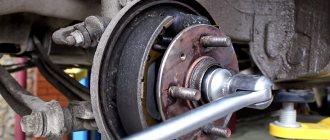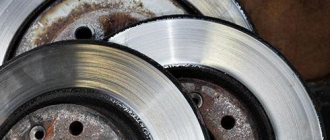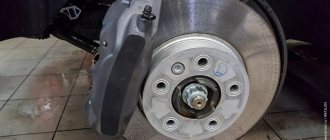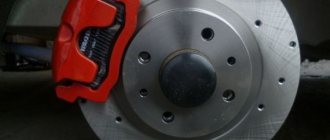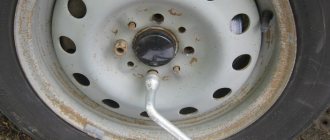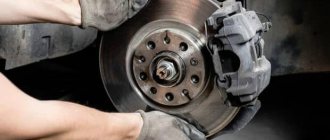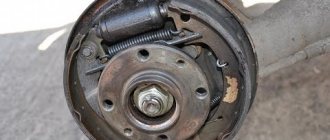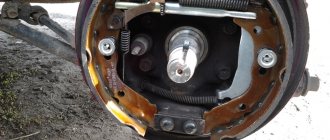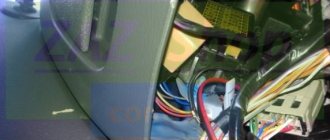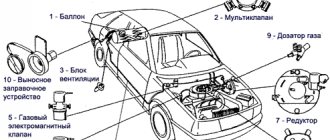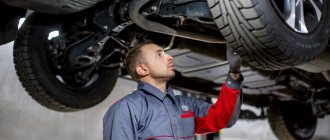Even the most durable surfaces of materials are destroyed by friction. Parts and spare parts for the brake system of the VAZ 2108 are made from durable, reliable and resistant materials, but unfortunately they will not last you forever. During operation, gaps, scratches, cavities, and depressions are formed, which significantly and noticeably deteriorate the performance of the braking system. To avoid replacing brake system parts, boring the VAZ 2108 brake drums will help. This publication will tell you how to boring the VAZ 2108 brake drums.
Brake drums of the VAZ 2108 are also subject to wear, like discs and pads. Considering that sand and dirt gets in while driving, this leads to all other uneven output. It's quite easy to diagnose. While driving at low speed, apply the handbrake for a moment. If as a result of such actions the car shakes, this clearly indicates a malfunction. Boring the brake drums of the VAZ 2108 will help solve the problems.
Boring brake drums VAZ 2108
– It must be remembered that wheel bolts can only be loosened and tightened with the vehicle on the ground.
– First you need to remove the drums.
Having established the first gear, support the front wheels with blocks. Lift the rear of the car onto a special support. Now you can remove the wheels.
– Now you need to clean the brake mechanism. But keep in mind that doing this with gasoline is prohibited. Use detergent.
– You will see two guide pins on the drum; unscrew them. Now remove the drums.
– Inspect the internal working surface. Having detected damage to the drum in the form of marks and scratches, it is necessary to measure the diameter and determine the amount of wear. The measuring device is called a caliper.
– The permissible drum diameter can be 201.5 mm. If the diameter exceeds the maximum permissible size, it will need to be replaced on both sides.
– If you find marks on the brake drum, then it is necessary to bore the VAZ 2108 brake drums to such a size that the diameter is 201 mm.
– Boring of VAZ 2108 brake drums is possible with your own hands. Unfold the drum, making the working surface outside. Start the engine. Engage first gear. The wheel will begin to rotate. Apply a sanding knife and sand away any rough edges.
The following video demonstrates the process of turning brake drums.
Hi all! I think you are well aware that the brakes in a car work based on friction. And friction has a destructive effect, gradually erasing the surfaces in contact with each other. Moreover, this does not depend on how durable the material is. It's just a matter of time. Therefore, grooving brake drums will become a very relevant topic for discussion.
Drum mechanisms (DM) of a car brake system are mainly made of durable and wear-resistant materials. But wear and tear still occurs gradually. I think everyone understands that driving a car with worn brakes is extremely dangerous and uncomfortable due to vibrations, whistling, grinding and long braking distances.
It is worth talking about such a concept as flow or boring. Why is it needed, how is it done, is there acceptable wear in the units, and isn’t it better to just install new drums. We have already talked about how to determine brake disc wear. The issue of their correct groove was also discussed. Now it's the turn of the reels.
So why is it important to maintain minimum brake disc thickness tolerances?
How to check the thermostat at home video
As with any complex mechanism, and the brake system is such, there are dependencies of the parts on each other. In disc brake systems, the maximum amount of piston exit from the brake caliper body is of great importance, which is why the thickness of the brake disc and the amount of wear of the brake linings are important. If the wear values of the disc and linings are maximum and outside the permissible limits, then there is a possibility that the piston will come out of the caliper to an unacceptable value and simply fall out, which will lead to more serious damage
It is for these reasons that Oem-zap specialists always pay attention to maximum wear values.
Design features
Many modern and not so modern cars and trucks, such as Kamaz (a very popular truck) or Gazelle, often have a rear braking system. It consists directly of the brake drum itself, as well as the so-called pad routing mechanism.
Moreover, in such a system it is the car brake drum that is the key component. The process of stopping the vehicle is realized due to the fact that contact between the drum and the pads begins when the driver presses the corresponding pedal. This activates the process of mutual friction, thereby reducing the speed and finally stopping the car. Drum mechanisms are usually based on high-strength cast iron.
During braking, a huge load is applied to the drum and mating shoe. Moreover, the higher the speed of the car at the moment of braking and the force applied to the pedal, the higher the load.
When operating vehicles in difficult conditions, an additional pollution process begins. Various dirt accumulates between the pads and drums.
Since the contacting surfaces (drum and shoe) are made of different materials, various types of defects and signs of deformation gradually appear on the drums. This is dangerous because the elements do not touch completely, the contact area decreases, and braking efficiency decreases. All this makes it necessary to periodically inspect the unit, as well as engage in preventative measures. Otherwise, you may miss the moment when the system fails. I won't talk about the consequences. Everything is obvious.
And here that same groove comes to the rescue. In fact, this is an alternative to replacing the brakes when they wear out.
What is a groove
Many people are interested in how to grind and restore the normal contact area, returning the brake assembly to its previous efficiency. Balancing or prevention is carried out by grooving or boring.
The essence of the procedure is to sharpen the edge of the working surfaces of automobile drums. This allows you to create a minimum gap between the two rubbing surfaces. But everything has a limit. Or rather, acceptable wear. When it is reached, boring will become pointless. Need a replacement. Usually the pads are changed after 50-80 thousand kilometers. Preventative checks and grooving are done after 20-30 thousand kilometers or as needed. Sometimes prevention is done more often, reducing the interval to 15-20 thousand km.
In fact, when grooving, surface defects and various types of irregularities that appeared on the unit during operation are removed. The task is to remove the layer of cast iron. To do this, use a stand or a special machine.
In the operating instructions you can find out what the minimum thickness of the drum is.
Cost of work
Boring or so-called grooving of brake drums is presented in the form of grinding an edge in the area of the working surface of the drums in order to prevent and prevent more serious problems with the drum system. The result of the procedure is the creation of a minimum gap between the block and the drum.
The need for this kind of prevention arises every 20-30 thousand kilometers due to active friction of the brake system parts, while in city conditions this figure is reduced by almost half - every 15 thousand kilometers. Grooving brake drums involves using a machine or a specialized stand to remove the top layer of metal, and along with it, all irregularities and defects on the surface are destroyed. This preventive maintenance can be repeated several times until the thickness of the drums becomes the minimum acceptable. This parameter is specified in the operating instructions.
When grooving is required
When restoring effective braking on the rear components when working with your own hands, they usually turn the elements on a lathe, since not all motorists have a stand. Such equipment is available only in a car service center. They can be found in huge quantities in cities such as St. Petersburg, Moscow, Yekaterinburg, as well as smaller towns.
Before sharpening devices, knowing full well that the price for the service is far from small, you need to make sure that there are any malfunctions.
This can be recognized by the following signs:
- During the braking process, strong or light vibrations are observed that were not previously present;
- When the driver presses the brake pedal, an extraneous noise is felt;
- The overall efficiency of the brakes decreases;
- When you press the pedal, the car begins to slide to the sides;
- The car stops as if in jerks;
- There is a beating sensation in the pedal;
- A similar beat is transmitted to the steering wheel;
- The braking distance increases.
Grooving stages
The grooving procedure itself consists of 3 key steps. This is precisely the principle that specialists adhere to, and those who do the work with their own hands rely on it.
- First stage. At the first stage, the initial removal of a layer 0.5 mm thick is carried out. This makes it clear how much the drum material is worn, what its current condition is, and whether there are more serious defects;
- Second phase. Next comes the procedure of smoothing, leveling and subsequent removal of all existing irregularities. About 0.25 mm of the metal layer is removed;
- Third stage. He's the finisher. This involves finishing sanding and removing all remaining small nicks and chips.
Having sharpened the brakes, a smooth working surface remains, and braking efficiency increases significantly.
But this procedure only allows you to get rid of irregularities. If there are geometric errors, the groove will not help at all. Similar phenomena occur if strong temperature changes occur.
To what extent this is a correct and rational decision, draw your own conclusions. And share your opinion in the comments.
Thank you for your attention! Subscribe, leave reviews, ask questions and tell your friends about us!
(
1 ratings, average: 5.00 out of 5)
Did you like the article?
Subscribe to updates and receive articles by email!
We guarantee: no spam, only new articles once a week!
How should brake drums be machined correctly on cars or trucks? Should you do this yourself, or should you trust the professionals? Let's look at this seemingly not very complicated process.
Boring of brake drums for trucks and cars
Many cars are still equipped with a rear braking system, which consists of a brake drum with a self-adjusting mechanism installed in it. When operating a car in the territories of post-Soviet countries, this mechanism becomes clogged quite quickly every 9-14 thousand km. mileage it practically stops working correctly . However, if you do timely maintenance of this system, then the rear drum brakes themselves are quite effective.
One of the most important points in the prevention of the braking system, both for cars and trucks, is the grooving or boring of the brake drums (the edge on the working surface is machined). As a result, after correctly replacing the pads and reassembling the brake mechanism, the minimum permissible gap between the pads and the surface of the drum will be ensured.
Brake pads in a drum-type brake system must be replaced when the mileage reaches about 60-80 thousand km. But preventive maintenance of the braking system, and in particular the pads, should be carried out at least every 20-30 thousand km. When operating a car in a city, the frequency of use of the braking system, as well as the load on it, increases many times. Frequent use of brakes leads to quite strong heating, which sharply reduces efficiency and has a very negative effect on the performance of their direct functions.
The material from which the brake pads are made has a non-uniform structure, and therefore, during operation, grooves and furrows are formed on the working surface of the drum along the entire radius, and partial deformation occurs. This leads to vibration and increased wear of the pads, and as a result, a significant decrease in braking efficiency.
Rules for designing a site for servicing drum brake systems
The main posts of the section ensuring the restoration of drum mechanisms:
- lift for removing worn elements and reassembling products;
- measuring stand and equipment for machining;
- table for cleaning and restoring pads by applying new friction linings.
To remove units from heavy-duty vehicles, a special lift with rigging equipment is used, and the drum is placed on a trolley. The measurement is made using a caliper at several points. To install the element in the boring machine spindle, an adapter sleeve is used. At the same time, linings and clearance adjustment mechanisms are serviced and worn parts are replaced.
Grooving brake drums of trucks and cars - malfunctions
For both trucks and cars, there are two ways to restore the brake system:
- replace the brake drums with new ones;
- Grind the brake drums.
The optimal solution in this situation is to buy new drums. But often the cost of replacing parts with new ones is quite high. And with constant use of the car, the additional costs may not be affordable for everyone. The option of boring car drums is cheaper, so it is in great demand among motorists. It is this method of solving this problem that many of our fellow citizens are increasingly resorting to.
To grind or bore - this means that on a special machine or stand, using the grooving method, defects and irregularities are eliminated from the working surface by removing (removing) a layer of metal. Experts sometimes call this process restoration or preventive maintenance.
So how much exactly should you withdraw? For each individual model, the manufacturer sets the minimum allowable thickness. These are precisely the numbers that are normatively acceptable. And you can see them either in the user manual, if the car has standard drums, or in the operating instructions from the manufacturer.
Brake system repair services at low prices:
| Title and content of work | Prices | Note |
| Diagnostics of the brake system and chassis (without disassembly) | 1,000 rub. | |
| Diagnostics of the brake system and chassis | 3,000 rub. | |
| Replacing brake pads on a car with disc mechanisms | 2,400 rub. | Front axle |
| Replacing brake pads on a car with disc mechanisms | 3,000 rub. | Rear axle |
| Replacing brake pads on a car with drum mechanisms (1 axle) | 4,000 rub. | Front axle |
| Replacing brake pads on a car with drum mechanisms (1 axle) | 4,800 rub. | Rear axle |
| Replacing brake pads on a car with a drum mechanism (1 axle) | 3500 rub. | Front axle |
| Brake pads - replacing linings (pads removed) | ||
| Removing/installing the brake caliper – (brake pads removed) | ||
| Brake caliper repair (caliper removed) | 4,000 rub. | Rear axle |
| Brake caliper repair (caliper removed) | 350 rub. | For 1 piece |
| Replacement of brake discs and pads – 1 wheel | 2,000 rub. | |
| Replacement of brake discs and pads – 1 wheel | 2,400 rub. | Repair using a small repair kit (nickels, boots) |
| Removal/installation of the brake disc (brake pads removed) | 4,800 rub. | Repair using a complete repair kit |
| Wheel assembly with brake drum - dismantling/installation | 4,500 rub. | Front axle |
| Brake drum - dismantling/installation (replacement) with the wheel removed | 5,000 rub. | Rear axle |
| Grooving the brake drum (drum removed) | 5,600 rub. | Final drive axle |
| Brake pad pins and rollers - replacement | 600 rub. | |
| Dirt guard of the brake mechanism - dismantling/installation (replacement) With the brake pads removed | 600 rub. | |
| Brake lever - removal/installation (replacement) | 1,000 rub. | |
| Brake shaft - dismantling/installation (replacement) with brake pads removed (excluding hub removal) | 980 rub. | For 1 wheel |
| Brake shaft - restoration (shaft removed) | 490 rub. | For 1 wheel |
| Adjusting the brakes | 700 rub. | |
| Adjusting the brakes | RUB 1,960 | |
| Energy accumulator – dismantling/installation (replacement) | 1,000 rub. | |
| Energy accumulator – dismantling/installation (replacement) | 600 rub. | Two-axle tractor |
| Brake chamber - dismantling/installation (replacement) | 1,000 rub. | Three-axle tractor |
| Brake chamber - dismantling/installation (replacement) | 1,500 rub. | Drum brakes |
| Brake chamber (repair) - removing the diaphragm | 1,500 rub. | Disc brakes |
| Replacing the ABS sensor | 1,200 rub. | Drum brakes |
| s/u, brake hose replacement | 1,200 rub. | Disc brakes |
| s/u, brake ratchet replacement | 800 rub. | Brake chamber removed |
| Brake liner | 500 rub. |
It is important to understand that rebuilding the brake system of trucks, especially imported and domestic ones, is significantly different. Therefore, you should not compare the repair of the MAZ brake system, for which someone you know spent less time or money, and the repair that is necessary for your truck
The number of drive axles will also affect the final cost; for example, repairing the brake system of a KAMAZ with two drive axles will cost less than repairing the brake system of a ZIL, which has all three drive axles.
